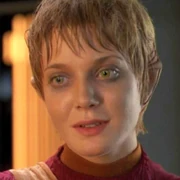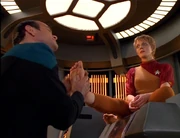Renegade54 (talk | contribs) m (formatting, + header) |
Archer4real (talk | contribs) No edit summary Tag: VE: Source |
||
| (9 intermediate revisions by 6 users not shown) | |||
| Line 1: | Line 1: | ||
| − | {{ |
+ | {{multiple}} |
[[File:Kes Elogium.jpg|thumb|First signs of ''elogium'']] |
[[File:Kes Elogium.jpg|thumb|First signs of ''elogium'']] |
||
{{ep disambiguation|VOY}} |
{{ep disambiguation|VOY}} |
||
| + | The '''''elogium''''' was the physiological process in which an [[Ocampa]]n [[female]] underwent "the time of change" and their body prepared for [[fertilization]], similar to [[puberty]] in [[Human]]s. |
||
| ⚫ | |||
| + | |||
| ⚫ | The ''elogium'' happened only once in a lifetime – usually between the ages of four and five years. An Ocampa female needed to conceive during this time if she was to have a child. In order to prepare the female for conception, a [[mitral sac]] – where the offspring would grow – started developing in the posterior part of the neck. Some side effects of this condition included high fever, hypertension, a dangerously elevated heartbeat, and delirium with elements of anxiety and paranoia. A significant increase in appetite for strange food sources also developed. Perspiration, changes in eye color, and discoloration of the [[skin]] surrounding the eyes may have also been evident. |
||
[[File:The Doctor massages Kes.jpg|thumb|left|The Doctor performs the ''rolissisin'']] |
[[File:The Doctor massages Kes.jpg|thumb|left|The Doctor performs the ''rolissisin'']] |
||
| − | An Ocampan ritual to prepare a woman before conceiving |
+ | An Ocampan ritual to prepare a woman before conceiving was the ''[[rolissisin]]'', in which the [[foot|feet]] were [[massage]]d until the [[tongue]] swelled. This task was usually performed by the woman's father. The ''rolissisin'' was performed soon after the appearance of the ''[[ipasaphor]]''. This bonding ritual was a time during which parent and child moved into a new kind of relationship, for when the child had her own child, the parent acknowledged her true adulthood. After the ''ipasaphor'' appeared, there were only fifty hours to begin the mating process, which consisted of the female remaining bonded to her mate for six days to ensure conception. |
| + | |||
| + | {{bginfo|It was never actually explained how the Ocampa could survive as a species given the nature of the ''elogium'', as it was explicitly stated that it would only occur once in an Ocampan's natural life, meaning the population would drop by half each generation. This, combined with their short lifespan, would normally cause a species to become extinct in a relatively short time. It is entirely possible that multiple births were possible (and, in fact, would need to be common) among the Ocampa, but this was never mentioned and dialogue suggested that Kes expected to only have one child.}} |
||
In [[2371]], when the {{USS|Voyager}} encountered a swarm of [[space-dwelling lifeform]]s, [[Kes]]' [[metabolism|metabolic]] activities accelerated and she went through her ''elogium'' prematurely. In Kes' case, the ''rolissisin'' was performed by [[The Doctor]] because neither of her parents were present on ''Voyager''. She wanted to mate with her partner, [[Neelix]], who was initially somewhat unsure about becoming a father. However, when ''Voyager'' got out of the swarm, Kes' ''elogium'' stopped. The Doctor theorized that since it was brought on by an outside source, she would still be able to conceive at the proper age. ({{VOY|Elogium}}) |
In [[2371]], when the {{USS|Voyager}} encountered a swarm of [[space-dwelling lifeform]]s, [[Kes]]' [[metabolism|metabolic]] activities accelerated and she went through her ''elogium'' prematurely. In Kes' case, the ''rolissisin'' was performed by [[The Doctor]] because neither of her parents were present on ''Voyager''. She wanted to mate with her partner, [[Neelix]], who was initially somewhat unsure about becoming a father. However, when ''Voyager'' got out of the swarm, Kes' ''elogium'' stopped. The Doctor theorized that since it was brought on by an outside source, she would still be able to conceive at the proper age. ({{VOY|Elogium}}) |
||
| − | ''In an [[alternate timeline]] in which Kes was transporting through time to various stages of her life, she entered the ''elogium'' at the |
+ | ''In an [[alternate timeline]] in which Kes was transporting through time to various stages of her life, she entered the ''elogium'' at the proper time – conceiving a daughter, [[Linnis Paris|Linnis]], with [[Tom Paris]].'' ({{VOY|Before and After}}) |
[[de:Elogium]] |
[[de:Elogium]] |
||
Latest revision as of 16:18, 27 September 2022
(covers information from several alternate timelines)

First signs of elogium
The elogium was the physiological process in which an Ocampan female underwent "the time of change" and their body prepared for fertilization, similar to puberty in Humans.
The elogium happened only once in a lifetime – usually between the ages of four and five years. An Ocampa female needed to conceive during this time if she was to have a child. In order to prepare the female for conception, a mitral sac – where the offspring would grow – started developing in the posterior part of the neck. Some side effects of this condition included high fever, hypertension, a dangerously elevated heartbeat, and delirium with elements of anxiety and paranoia. A significant increase in appetite for strange food sources also developed. Perspiration, changes in eye color, and discoloration of the skin surrounding the eyes may have also been evident.

The Doctor performs the rolissisin
An Ocampan ritual to prepare a woman before conceiving was the rolissisin, in which the feet were massaged until the tongue swelled. This task was usually performed by the woman's father. The rolissisin was performed soon after the appearance of the ipasaphor. This bonding ritual was a time during which parent and child moved into a new kind of relationship, for when the child had her own child, the parent acknowledged her true adulthood. After the ipasaphor appeared, there were only fifty hours to begin the mating process, which consisted of the female remaining bonded to her mate for six days to ensure conception.
In 2371, when the USS Voyager encountered a swarm of space-dwelling lifeforms, Kes' metabolic activities accelerated and she went through her elogium prematurely. In Kes' case, the rolissisin was performed by The Doctor because neither of her parents were present on Voyager. She wanted to mate with her partner, Neelix, who was initially somewhat unsure about becoming a father. However, when Voyager got out of the swarm, Kes' elogium stopped. The Doctor theorized that since it was brought on by an outside source, she would still be able to conceive at the proper age. (VOY: "Elogium")
In an alternate timeline in which Kes was transporting through time to various stages of her life, she entered the elogium at the proper time – conceiving a daughter, Linnis, with Tom Paris. (VOY: "Before and After")
